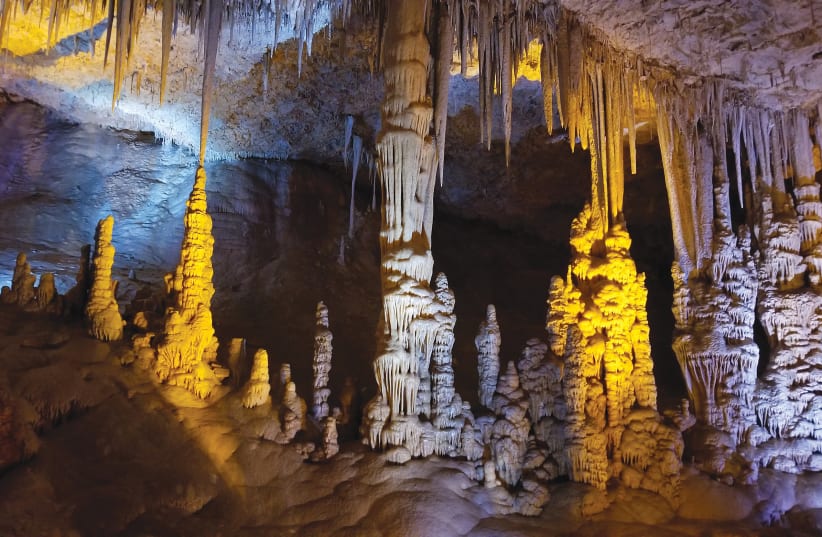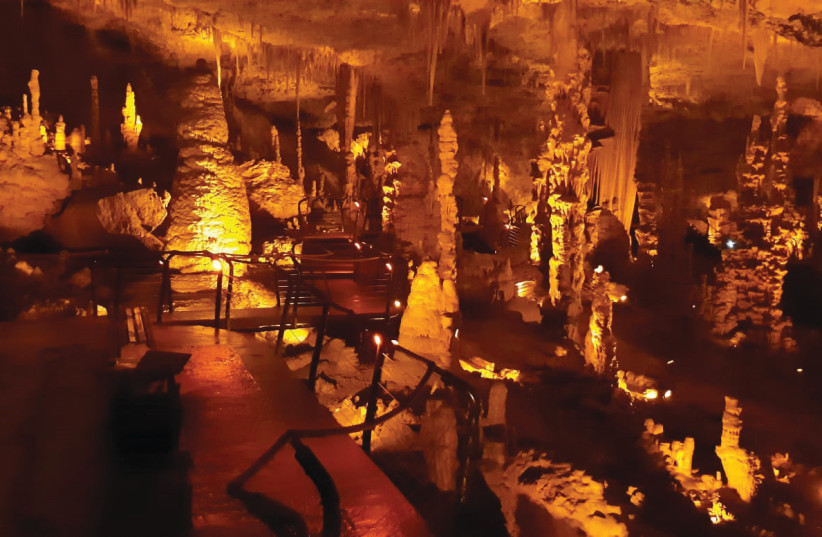Beauty was exposed in a wilderness area of Judea after the 1967 “explosion” of the Six Day War of Egypt, Syria and Jordan versus the Jewish homeland. The place in the biblical Land of Israel is small, exquisite, splendid. Its sources flow back. And when I first explored the locale a decade later, visitors were walking its paths. The gem, from long ago and beyond politics, has not revealed ancient artifacts, but rather is the story of a cave of living stone in the most physical sense.
A routine quarry rock-blasting in the late 1960s accidentally opened a door to Sorek Cave. On a bluff in the Judean wilderness less than 15 miles by air west of Jerusalem and half a mile or so south of the Valley of Sorek in the foothills of the Judean massif above Beit Shemesh, is the Sorek Stalactite Cave within Israel’s Avshalom Shaham Nature Preserve.
Stalactites, dripping fissures, stalagmites, calcareous formations, helictite growths, calcite rafts, travertine drips and films – these are geological terms for structures within the lovely cave (acknowledgment to “Israel’s Most Beautiful Cavern” by Michael Assaf, in Israel Land and Nature magazine, winter 1976-’77). Shaped like an irregular, sharply sloping (1:3 gradient) rectangular box, the cavern measures about 75 by 87 meters, the height averaging 16 feet and occasionally soaring to more than double that.
The whole cave is not large, but it is unusual and special in the huge variety of formations found within (something like Israel among the nations). The cave is alive – as stones and minerals go – and temperature and humidity are critical to keeping it so. The often hollow, dripping stalactites, and the steadily rising stalagmites, grow each year. The average temperature in the cave is a steady 79 degrees Fahrenheit; humidity varies from 75% in the entrance hall to 98%-99% in the interior. The visitor immediately feels heavy dampness, especially after the cave has been closed for several days.
Before the cave was opened to visits by tourists, the Israel Nature and Parks Authority made extensive preparations. Visits are carefully controlled. Were large crowds allowed and electric lights (set up to beautifully expose and highlight the multicolored stones, pools, and mineral deposits) left on for long periods, a guide explained to me, it was feared the temperature would rise and humidity lower, ruing the slow growth within the cave.
Paths have been prepared to traverse the irregular sloping floor of land-slide terraces, hardened mineral drippings and natural steps. The cavern is naturally divided into sections and halls. Water pools lay about and reflect the colors according to the orchestration of the soft white-yellow lighting system.
The natural dome over the cavern is a mass of mountainside gray dolomite. The mass of rock varies in thickness (cavern roof to the outside surface) from about 39 meters to 156 meters, and weighs an estimated 400,000 tons. The fissures and cracks in this rock cover creep down to the roof. Rainwater sometimes carries clay and mud into the cave. Several skeletons of reptiles in various stages of petrification have been found that attest to connections with the outside surface, and nature.
Live stalactites are often as much as two meters in diameter. After heavy rains outside, actual thin streamlets can sometimes be seen flowing within the cave. Some water settles in the pools, while another portion drains through sinkholes in the floor of the cavern to yet lower levels. Some pools are permanent, others only fill up seasonally, after downpours. Various higher water levels in the pools can be distinguished from the encircling ring markings on the walls. Most of the cave floor, however, is dry.
To protect this natural treasure, the cavern was long closed by the Nature and Parks Authority. A careful study was made, and plans were prepared. Essential installations were completed in 1976, which have since facilitated the controlled visits by the public, accompanied by guides stationed at the cave. The entrance is immediately sealed after the brief openings, which permit access and egress of visiting groups. Within the entrance are concrete support walls and an enclosure with seats where guides usually give initial and closing presentations/explanations.
A “floating” boardwalk, which does not disturb the natural drainage system, delicately meanders through the cavern. The quite suitable fluctuating lighting system on and off plays upon the absorbing rock formations and the pools. All of this has been designed with an eye to ensure visitors’ safety and safeguard the rare beauty of the cavern.
The Sorek Stalactite Cave is near the birthplace of Samson, the biblical Samson, down the valley where the Bible relates that David finally vanquished the Philistines. The fitting centerpiece memorial was named Avshalom Shoham Nature Reserve, honoring the courageous military scout who died from wounds suffered during the War of Attrition at the Suez Canal, the then-frontier line of Israel with Egypt in the mid-1970s. ■
The writer, who took the Israel tour guide course, says he had the honor to visit and explore the area of the cave many times.

